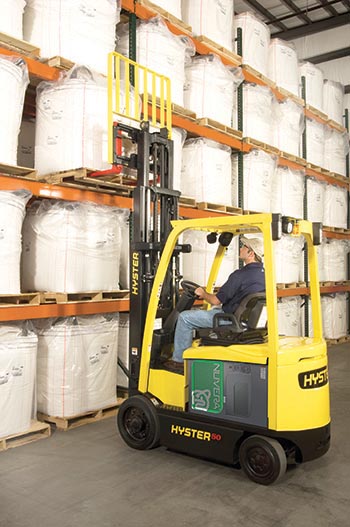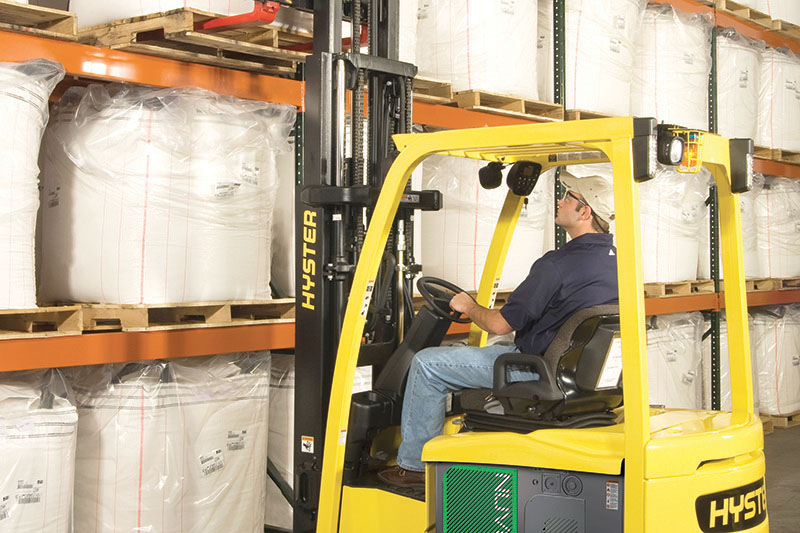Lift Truck Tip: Powering productivity
Fleet owners and forklift OEMs are exploring a brave new world of motive power, where chocolate and vanilla have been replaced with a kaleidoscope of options.
The Great Recession taught an unforgettable lesson in the value spent on forklifts and their operation. Since then, the conversation around forklift power sources has taken several twists and turns. First, a sizable migration began from internal combustion to electric, then fuel cells and lithium-ion alternatives became more broadly viable, and now driverless forklifts are in the mix.
“We continue to see triple-digit growth in lithium-ion, and thin plate pure lead (TPPL) is coming on really strong, so customers are seeing a kaleidoscope of options,” says Steven LaFevers, vice president of emerging technology for Hyster.
 LaFevers cites three trends driving innovation in the motive power space. The first is increasing customer desire for access to a comprehensive suite of power solutions. Second, with an eye toward minimizing the need for a forklift operator to care about how the unit is powered, an ever-growing interest is in integrated operator systems, including sensors and safety systems, telematics and operator-assist technologies like automatic braking and speed control. The third revolves around driverless or automated forklifts.
LaFevers cites three trends driving innovation in the motive power space. The first is increasing customer desire for access to a comprehensive suite of power solutions. Second, with an eye toward minimizing the need for a forklift operator to care about how the unit is powered, an ever-growing interest is in integrated operator systems, including sensors and safety systems, telematics and operator-assist technologies like automatic braking and speed control. The third revolves around driverless or automated forklifts.
“There’s an evolution,” LaFevers says. “When we started to invest in telematics, companies wanted to monitor and understand damage. Now, with LIDAR and sensors to avoid damage, the trend we’re seeing is a shift from monitor to prevent. They want to avoid things that can hurt staff or production.”
As fleet expenses and waste came into sharper focus, a heavier burden was placed on operators in terms of productivity and power management. Consider the latest fast-charging technologies, which require disciplined adherence to charging schedules.
“There are Fortune 500 companies whose operators are failing to plug in forklifts 40% to 60% of the time,” LaFevers says. “Some are set up so they need to charge every single break, and any application with that kind of tolerance is set up to fail. If you are a lithium, fast charge or TPPL customer and don’t follow the regimen, you will pay two to three times the cost and achieve literally the same power delivery.”
LaFevers recently visited a site with nine large, power-intensive charging stations for lithium-ion equipment. Of the trucks parked in the charger bays, only one was plugged in. “That’s a piece you have to ask yourself: What is the likelihood that the operator will fail to charge?” he says. “Then change your math. It starts to really put some holes in the payback model.”
Holes in data collection practices present opportunities to find and quantify efficiencies. LaFevers explains that some customers have advanced warehouse management and labor management systems with very visible data sets. Many have an equally robust fleet telematics data set.
“But between the two there are some major black holes until you tie them together,” he says. How much time elapses from when an operator clocks in to the time he gets on the truck? Do you know how much time it takes to make a pick, but not the travel time to the pick? “There is an unquenchable appetite for data, but at the same time customers don’t always have time to do anything with the data. So they want data providers who are more and more versatile and can make data easier to understand.”













